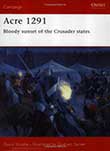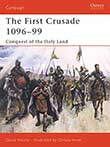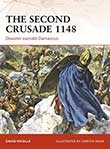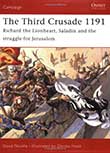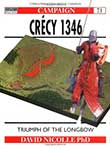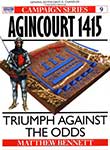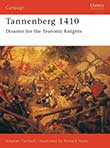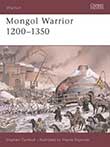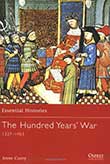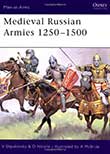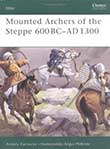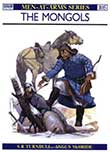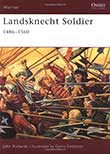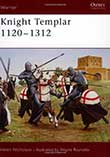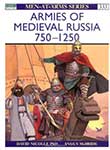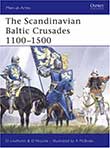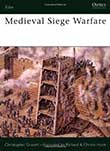

Osprey's study of the battle at Acre, one of the last campaigns of the Crusages (1095-1291). In April 1291, a Mamluk army laid siege to Acre, the last great Crusader fortress in the Holy Land. For six weeks, the siege dragged on until the Mamluks took the outer wall, which had been breached in several places. The Military Orders drove back the Mamluks temporarily, but three days later the inner wall was breached. King Henry escaped, but the bulk of the defenders and most of the citizens perished in the fighting or were sold into slavery. The surviving knights fell back to their fortress, resisting for ten days, until the Mamluks broke through. This book depicts the dramatic collapse of this great fortress, whose demise marked the end of the Crusades in the Holy Land.
In 1095 the Byzantine Emperor Alexios I appealed to the Christian states of western Europe for help against the Turks who had swept across the Empire after the disastrous Byzantine defeat at Manzikert in 1071. This book is about the First Crusade (1096-1099) that followed, and saw several armies of ‘armed pilgrims’ march across Europe to the Holy Land. They were unleashed on a divided and fragmented Islamic world and won a series of apparently miraculous victories, capturing the Holy City of Jerusalem itself. The success of the First Crusade was never to be repeated, however, and triggered two centuries of bitter warfare, the repercussions of which are still felt today.
After the fall of the crusader kingdom of Edessa, the Pope called for a new crusade in 1145. This new campaign by the Christian west against the forces of eastern Islam would culminate in the 1148 siege of Damascus, then the capital city of an Islamic state that had been friendly towards the crusaders. Despite the earlier successes for the crusaders at Antioch and Jerusalem, and the weak fortifications around Damascus, the siege proved a dismal and embarrassing failure for the western armies. The siege was abandoned soon after it had started and the crusaders retreated. This defeat shocked the Christian world and dealt a severe blow to the confidence of the crusading armies, while bolstering the morale of their enemies.
Utilizing numerous illustrations and full-color artwork, medieval warfare expert David Nicolle analyzes the often-debated battles around Damascus, explaining how the domination of the surrounding countryside by the Islamic forces became the decisive factor, and how the besieging crusading forces found themselves under siege. He also looks at the crusade in the larger context of the battle between East and West and explains how the Second Crusade proved a turning point in this ongoing struggle.
The clash between King Richard I ‘The Lionheart’ of England and Saladin has become legendary. Throughout the ages, military enthusiasts have been fascinated by the strategy of the resolute, heavily armed Anglo-Saxon army versus their more lightly armed opponents. Richard’s inability to recapture Jerusalem was disappointing, but it proved to the crusaders that Saladin was not invincible. This book describes the struggle of the Crusades (1095-1291) that has evolved into a mythic campaign for the Holy City of Jerusalem, providing an in-depth look at the battle, the personalities involved and the tactics employed by each army.
The Battle of Crecy was the first major land battle of the Hundred Years War (1337-1453). It pitted the French army, then considered the best in Europe, and their miscellaneous allies against the English under King Edward III and the ‘Black Prince’, who as yet had no great military reputation; this was the battle where he ‘won his spurs’. The Genoese crossbowmen were outshot by the English longbows and the pattern was set for the rest of the day: the French cavalry were committed piecemeal in fruitless charges against strong English positions, losing perhaps 10,000 men in the course of the fighting. After almost a millennium in which cavalry had dominated the field of battle, the infantryman, and particularly the longbowman, now ruled supreme.
Osprey's Campaign title for one of the most important campaigns of the Hundred Years' War (1337-1453). Agincourt is one of the most evocative names in English military history. Henry V's forces were tired, hungry, and faced a French army three to six times more numerous. However, they possessed several advantages, and English success resulted from the combination of heavily armoured men-at-arms with troops armed with the infamous longbow - the havoc this weapon wreaked was crucial. Using original fifteenth century evidence, including the surviving French battle plan and the accounts of men present in both armies, this title discusses the lead-up to the battle, the tactical dispositions of the two forces and the reasons for the ultimate English success.
By 1400 the long running conflict between the Order of Teutonic Knights and Poland and Lithuania was coming to a head, partly as a result of the Order’s meddling in the internal politics of its neighbours. In June 1410 King Wladislaw Jagiello of Poland invaded the Order’s territory with a powerful allied army including all the enemies of the Teutonic Knights – Poles, Lithuanians, Russians, Bohemians, Hungarians, Tartars and Cossacks. This book recounts how, when the armies clashed on the wooded, rolling hills near the small village of Tannenberg, the Teutonic Knights suffered a disastrous defeat from which their Order never recovered.
The Mongol warriors are one of the great success stories of world military history. Under the leadership of Genghis Khan and his successors the Mongols conquered much of the known world, fighting in territory ranging from the frozen steppes, the wilderness of Palestine, the jungles of Java and the great rivers of China. Through all this they showed a remarkable ability to adopt, adapt and improve a vast range of military techniques and technology, from siege weapons to naval warfare. This book tells the story of this remarkable military organisation, including details of weaponry, tactics, training and beliefs.
There can be no doubt that military conflict between France and England dominated European history in the fourteenth and fifteenth centuries. This war is of considerable interest both because of its duration and the number of theatres in which it was fought. In this book, Hundred Years’ War expert Dr Anne Curry reveals how the war can reveal much about the changing nature of warfare: the rise of infantry and the demise of the knight; the impact of increased use of gunpowder and the effect of the wars on generations of people around it.
After disastrous defeats at the hands of the Mongols in the 13th century, the Russian principalities became vassals of the Khans of the Golden Horde for more than 200 years; and at the same time the western princes faced the German crusaders of the Teutonic Order. Remarkably, Russia responded with a new surge of military vigour. Eventually, freedom from the 'Mongol yoke' coincided with a degree of unity around a powerful new state - Muscovy. This exciting chapter of history is illustrated with rare early paintings, photos, diagrams, and eight plates reconstructing the mixed influences of East and West in the appearance of Russian warriors.
For more than 2,000 years hordes of mounted nomadic archers from the vastness of the steppe and from Central Asia spewed out into China, the Middle East, and Europe. Feared and reviled, they were a formidable threat to the lands they invaded. Their influence on military history is incalculable: the whole foundation of late Classical and Medieval Western and Middle Eastern military thought was based on the reality of a highly mobile, tough and unconventional foe, one which could strike almost anywhere at will and with highly effective long-range weapons. This book details the history, weapons, equipment and tactics of these fascinating warriors.
The history of the Mongol armies is a catalogue of superlatives. No armies in history have ever won so many battles or conquered so much territory. No army has ever provoked such justifiable terror and loathing in its victims, or slaughtered so many of its vanquished. What other army in history has marched on Russia in the winter and survived, let alone won victories? The stories of these and many other amazing feats of this 'barbarian' people are here brought vividly to life by Stephen Turnbull, from the birth of Genghis Khan in the wind-swept steppes of Mongolia, through the conquest of China and beyond.
The Landsknecht (meaning 'servant of the country') flourished during a key period for military organisation and practice. In the late 15th century, the Holy Roman Emperor, Maximilian I, recruited thousands of mercenaries from Central and Northern Europe, with the aim of creating a reliable source of men for his armies – and the Landsknecht were born. This book reveals the true-life experiences of the Landsknecht soldier during conflicts such as those of the Italian Wars (1494-1559), using numerous first-hand accounts. It takes a close look at the recruitment, training, daily life and and careers of these formidable soldiers, and examines in detail their clothing, equipment and weaponry. Many fine, contemporary illustrations, some drawn by Landsknecht themselves, accompany the text.
The order of the Temple was a military-religious organisation that was set up to protect pilgrims and settlers in the Holy Land. The Templars believed they were God's warriors fighting on God's behalf and developed a fearsome reputation among the neighbouring Muslim rulers. This book examines the men who joined the order and why they joined it, focusing on those who fought in the Holy Land. Based on contemporary sources it provides an effective insight into the daily lives of the warriors, from their admission ceremony to their training, organisation in the field, and how they fought in battle.
In the centuries following the first expeditions down the great rivers of northern Russia by Viking traders and adventurers, the foundations for a new state were laid. Many influences combined in this colourful culture which grew up first around the great cities of Kiev and Novgorod – Scandinavian, Finnish, Slav, steppe Turkish, Byzantine. By the time of the Mongol invasions of the 12th century the small enclaves of the old pagan Rus’, tolerated by the Khazar Khans for their commercial usefulness, had evolved into a Christian nation. Its story is told here in fascinating detail, and illustrated with striking colour reconstructions of the warriors themselves.
Wielding their swords in the name of their faith, the crusaders originally set out to reclaim Jerusalem and its surrounding territory in the Middle East. Increasingly, however, Eastern Europe and the last remaining bastions of pagan Europe became the targets of their religious zeal.
The era officially began in 1147, when the Saxons, Danes, and Poles, responding to Pope Eugene III's call, initiated a crusade against the Wends of the Southern Baltic. This was followed by crusades against the Livonians, Estonians, Finns, Prussians, and Lithuanians. By the 13th century much of the responsibility for sustaining these crusades fell to the Teutonic Knights, a military order formed in the Holy Land in 1190. They were aided by the constant support of the Roman pontiff and by a steady flow of mercenaries from throughout Christendom.
The subsequent Scandinavian campaigns laid the foundations of modern Baltic society by destroying pagan rural farming settlements, and establishing fortified Christian towns and major castles. As with the majority of crusades, the prospective acquisition of land and power was the one of the key driving forces behind these bloody military expeditions.
This book reveals the colorful history of these Crusades when the soldiers of the Pope fought their way across Eastern Europe and inexorably changed the future of the continent.
During the Middle Ages siege warfare played a vital role in military strategy. Sieges were far more numerous than pitched battles, ranging from small-scale affairs against palisaded earthworks to full-scale assaults on vast strongholds. Needless to say, the art of siege warfare assumed a unique importance to both invader and defender alike. In this title Christopher Gravett explores the different aspects of medieval siege warfare, from chivalrous formalities to 'surprise and treachery', in a text backed by numerous illustrations including 12 full page colour plates by Richard and Christa Hook.
St. Gaius begins his reign as Catholic Pope
Ferdinand of Austria chosen as King of Bohemia
Pope Clemens VII publishes degree Cum ad zero - forms Inquisition
Spanish army begins fires in Haarlem Netherlands
Earl Leicesters army leaves Netherlands
French / Swedish troops occupy Breisach on the Rhine
England declares war on Spain
Bonnie Prince Charles army retreats to Scotland
France recognizes independence of English colonies in America
George Washingtons army returns to Valley Forge, Pennsylvania
New York City traffic regulation creates 1st 1-way street
1st impeachment trial against a US senator (Wm Blount, TN) begins
Kentucky abolishes debtors prisons
HMS Beagle / Charles Darwin sails in Strait Le Maire
1st Hawaiian cavalry organized
Anaheim Township created in Los Angeles County
Gen US Grant issues order #11, expelling Jews from Tennessee
Battle of Franklin, Tennessee
France declares Madagascar a protectorate
Russia ratifies Duple Alliance with France
Anti-Saloon League of America formed, Washington, DC
George Brownell patents a machine to make paper twine (Mass)
1st prize of 100, 00 francs offered for communications with extraterrestrials. Martians excluded-considered too easy
New Ellis Island Immigration station completed costing $1.5 million
At 10:35 AM, 1st sustained motorized aircraft flight (Orville Wright)
Ugyen Wangchuck became 1st hereditary King of Bhutan
Leopold II, King of Belgium, buried in Brussels
Austrian troops beat Russians in Limanova Poland
Great Britain declares Egypt a protectorate
Jews are expelled from Tel Aviv by Turkish authorities
Austria parliament approves 8-hour day
AL votes to let spitball pitchers to continue using it
British Empire receives League of Nations mandate to Nauru
Japan receives League of Nations mandate over Pacific islands
South Africa receives League of Nations mandate over SW Africa
Last British troops leave Ireland Freestate
Greek King George II overthrown by army / Republic
1st US diesel electric locomotive enters service, Bronx, New York
Colonel William "Billy" Mitchell court-martial for insubordination
Russia and Turkey sign non-aggresion pact
German Marx government falls due to cooperation with red army
KYA-AM in San Francisco CA begins radio transmissions
Lithuanian military state under General Augustine Woldemaras
Victoria score 793 against Queensland, Bill Ponsford 437
Cards trade Jim Bottomley to Reds for Estel Crabtree and Ownie Carroll
NFL starts official stats as Bears beat Giants 23-21 in champ game
Ventriloquist Edgar Bergen and dummy Charlie McCarthy, appear on TV
Utrecht Central Station destroyed by fire
German pocket battleship Graf Spee scuttled by its crew off Uruguay
British troops occupies Sollum
Dutch and Australian troops lands on Portuguese-Timor
German submarine U-31 sunk
German troops led by Rommel begin retreating in North Africa
Allies in London sentence German war criminals
Transport 63 departs with French Jews to Nazi-Germany
Green Bay Packers win NFL championship
Japanese-Americans released from detention camps
M-Ocean View streetcar resumes service and is extended to Market St
US Army announces end of excluding Jap-Americans from West Coast
US destroyers sink in storm off Philippines, 790 killed
Bradman and Barnes complete 405 run 5th wkt stand, score 234 ea
US V-2 rocket reaches 183 km, White Sands Proving Grounds, New Mexico
New York struck by a blizzard, resulting with 27" of snow
WEWS TV channel 5 in Cleveland, OH (ABC) begins broadcasting
"Regina" closes at 46th St. Theater NYC after 86 performances
Dutch Communist Party members forbidden to be civil servants
1st fully automated railroad freight yard (Gary, Indiana)
WEAU TV channel 13 in Eau Claire, WI (NBC) begins broadcasting
US successfully test-fires Atlas intercontinental ballistic missile
"On The Beach, " is 1st film to premiere on both sides of Iron Curtain
1st movie opening simultaneously in major cities (On The Beach)
"La Plume de Ma Tante" closes at Royale Theater NYC after 835 performances
"Take Me Along" closes at Shubert Theater NYC after 448 performances
Disgruntled employee set fire to a circus tent in Niteroi Brazil
India seizes Goa and 2 other Portuguese colonies
Niteroi Circus of Rio de Janeiro catches fire; 323 die
Beatles 1st British TV appearance (People & Places)
Current constitution of Monaco promulgated
Tsjoi Doo Sun forms government in South Korea
West and East Berlin sign accord about travel rules
Astrodome opens, 1st event is Judy Garland and Supremes concert
British government proclaims ends oil-embargo against Rhodesia
David Levy begins his search for comets
Dutch government shuts Limburgs coal mine
Largest newspaper-Sunday New York Times at 946 pages (50 cents)
WEDW TV channel 49 in Bridgeport, CT (PBS) begins broadcasting
50m TV viewers saw singer Tiny Tim marry Miss Vicky, on Tonight Show
USAF closes Project Blue Book, concluding no evidence of extraterrestrial spaceships behind thousands of UFO sightings
Gdansk, Poland shipworkers strike
"Diamonds are Forever" premieres in US
Cease fire between India and Pakistan in Kashmir
Radio Bangladesh begins transmitting
New line of control agreed to in Kashmir between India and Pakistan
WGVC (now WUCX) TV channel 35 in Grand Rapids, MI (PBS) 1st broadcast
Arabs terrorists shoot passengers on Boeing 737 to Kuwait
John Paul Stevens appointed to Supreme Court
Superstation WTBS in Atlanta went national
Bobby Simpson scores 176 Australia vs. India at the WACA, aged 41
Elvis Costello and The Attractions 1st US TV appearance (SNL)
OPEC raises oil prices 18%
Referendum approves new constitution of Rwanda
Budweiser rocket car reaches 1190 km/h (record for wheeled vehicle)
Mauritania provisional constitution published
Members of Red Brigades kidnap Brigadier General James L Dozier
"Peg" closes at Lunt-Fontanne Theater NYC after 5 performances
Disco in Madrid catches fire; 83 die
New Jersey Devils 1st shutout, Glenn Resch makes 42 saves beat Minn, 2-0
Mrs Davina Thompson makse medical history by having the 1st heart, lung and liver transplant (Papworth Hospital in Cambridge, England)
US Congress forms "Irangate" committee
77th Davis Cup: Germany beats Sweden in Gothenburg (4-1)
Bryan Murray becomes 17th NHL coach to win 300 games (Washington Capitals)
New York Islanders break 12 game losing streak, beat Devils 5-2
USS Tennessee, 1st sub to carry Trident 2 missiles, commissioned
78th Davis Cup: Germany beats Sweden in Stuttgart (3-2)
Brazil elects conservative Fernando Collor de Mello President
Patti Rizzo / Mike Hill wins LPGA Mazda Golf Championship
KTBN, Salt Lake City Utah, begins shortwave radio transmissions
Cleveland Cavaliers beat Miami Heat 148-80, by record 68 pts
Patrick Manning becomes Premier of Trinidad and Tobago
Soap opera "One Life To Live" airs its 6,000th episode
"Christmas Carol" opens at Broadhurst Theater NYC for 22 performances
Gen Suwa finds tooth of 4.4 million year old Australopithecus ramidus
Bangladesh moslem call for murder of feminist Taslima Nasrin
Kevin Scott skates world record 1000 m (1:12.54)
Northern Exposure star Barry Corbin falls off his horse
Tennis star Boris Becker (26) weds Barbara Feltus (27)
"School after Scandal" closes at Lyceum Theater NYC after 23 performances
